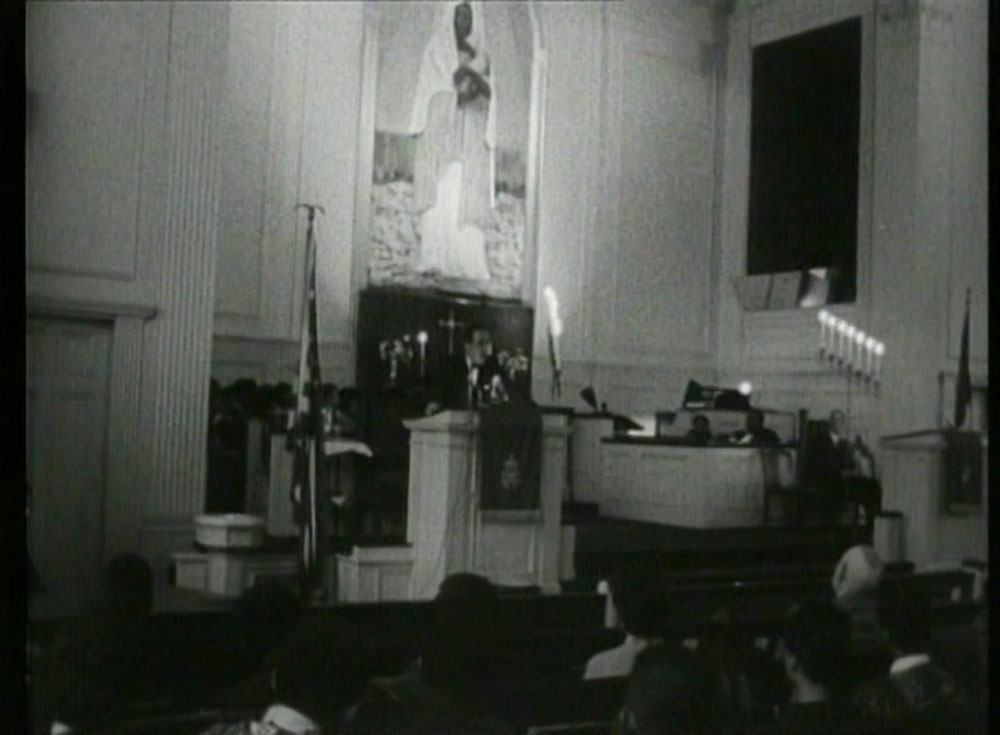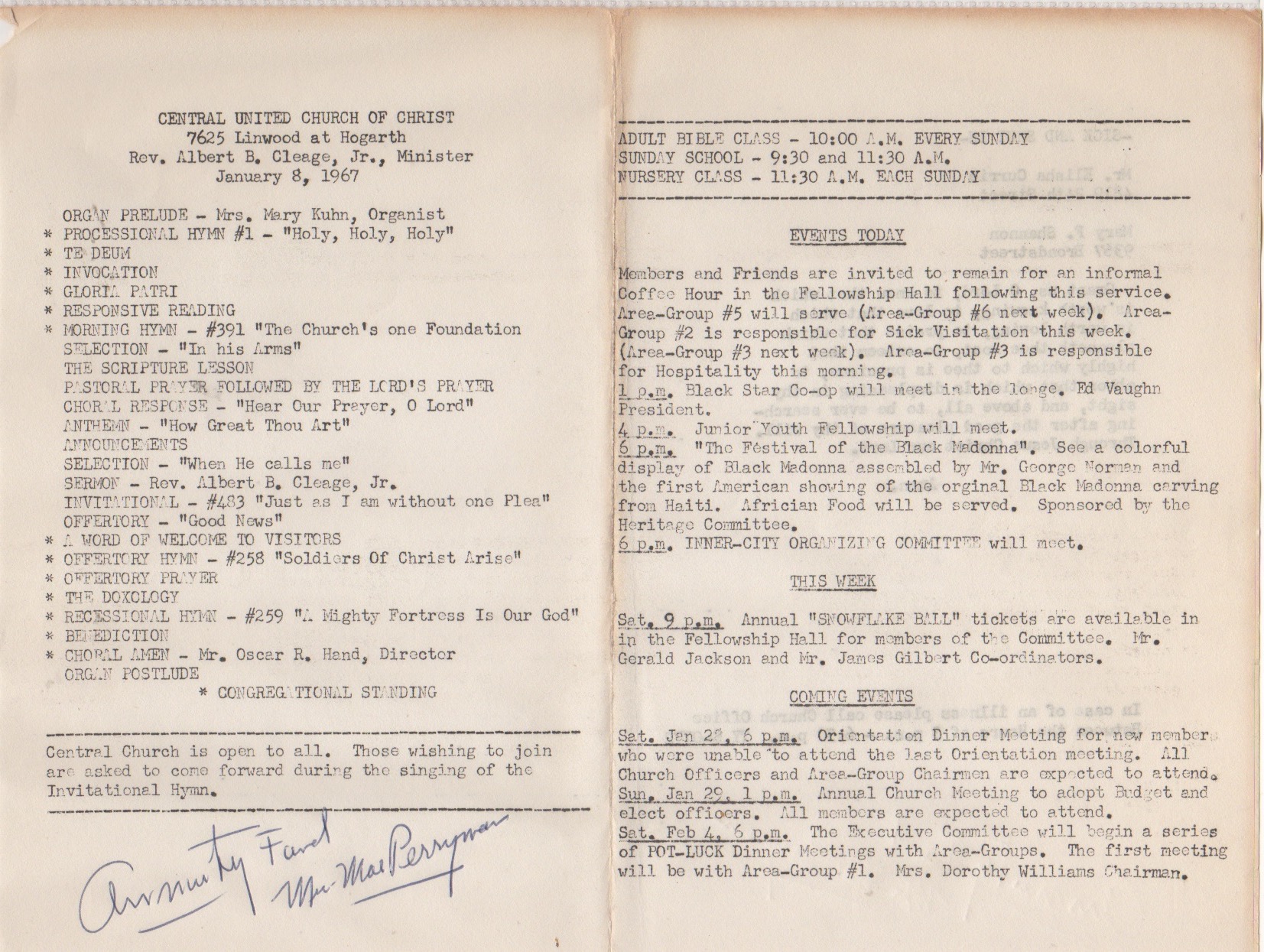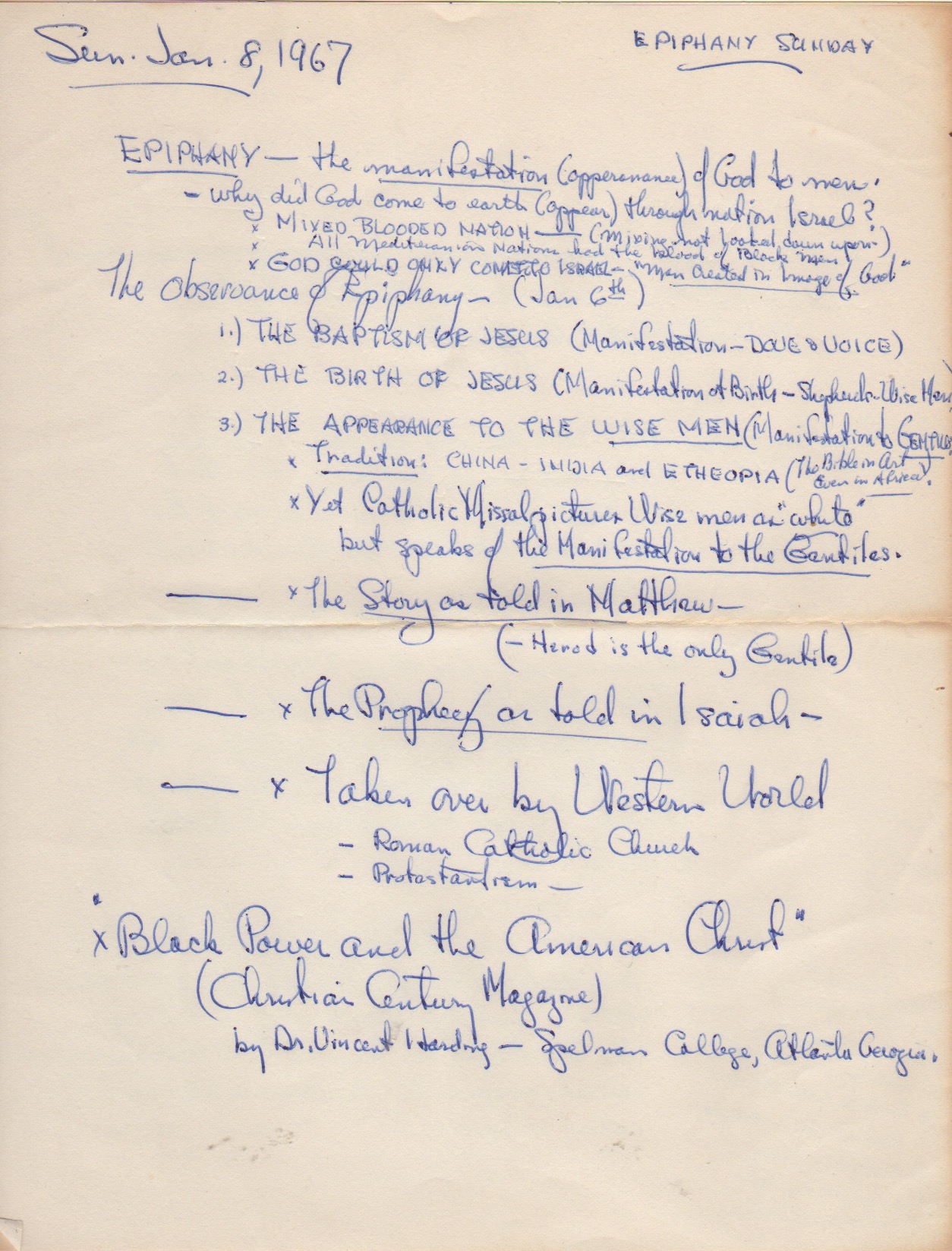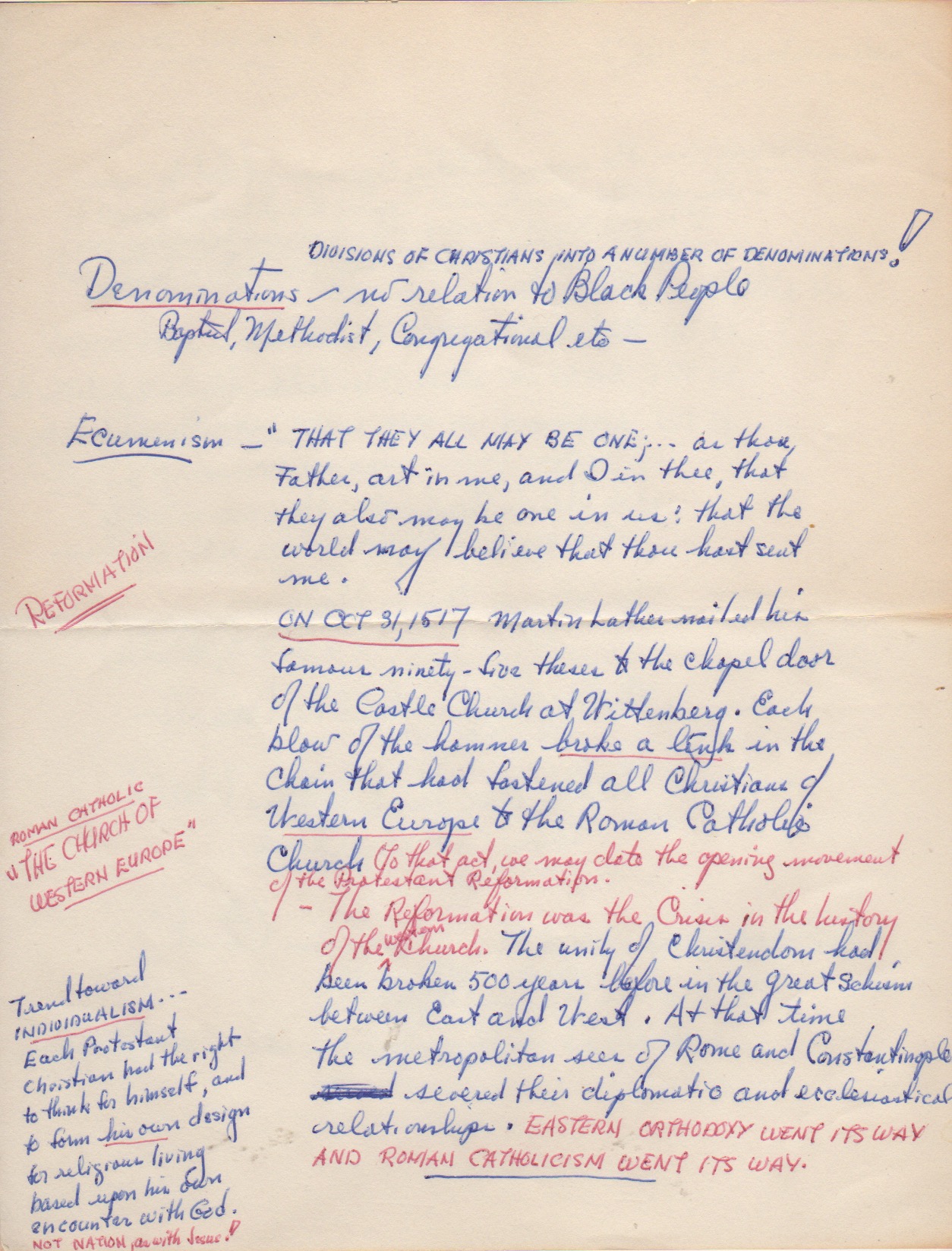 My father, then known as Rev. Albert B. Cleage jr preaching. This is rather a long sermon, about 45 minutes. He talks about growing up in the black church in Detroit with no use for religion until attending Plymouth Congregational Church and hearing Rev. White preach. He mentions attending Oberlin Seminary and finishes up by sharing a bit from an article by Dr. Harding in a religious magazine. This was just at the start of 1967. What a year was to come. Click on the documents below to enlarge.
My father, then known as Rev. Albert B. Cleage jr preaching. This is rather a long sermon, about 45 minutes. He talks about growing up in the black church in Detroit with no use for religion until attending Plymouth Congregational Church and hearing Rev. White preach. He mentions attending Oberlin Seminary and finishes up by sharing a bit from an article by Dr. Harding in a religious magazine. This was just at the start of 1967. What a year was to come. Click on the documents below to enlarge.
Epiphany Sunday January 8, 1967
Bulletin from that Sunday
Sermon Notes



Wow Kristin .Thank You for sharing this audio.I will listen through today. My Best Wishes to You in the coming year X
Last night I was moving my itunes list from my old to my new computer and came across this sermon. I really appreciated the part where he talks about his early church experience and how he came to go to the seminary. I didn’t remember that information, although I did the later part. I was also struck how much teaching there was.
Wow what a historic treasure you have!!!! It was very interesting and enlightening to hear your father speak.
Thank you Camille. Wish you could have heard him in person.
Dear Kris,
Thanx for another wonderfully interesting post, which included an audio recording of your father’s Jan. 8, 1967, “Epiphany Sunday” sermon at what was then known as Central United Church of Christ (it was renamed the Shrine of the Black Madonna in January 1968), that Sunday’s printed program and his sermon notes.
I’m glad that I lived long enough to see you exploit modern technology in such valuable ways. As I’ve told you many times before, you do this better than anyone else that I know, or know of.
On the other hand, I don’t think that this is one of your father’s better sermons. In much of it, he came as close to meandering as I’ve ever heard him, despite his notes.
Still, it’s historically valuable because you could hear him building up to Easter Sunday (March 26), when he would dramatically unveil the 19-by-eight-foot Black Madonna and child chancel mural painted by Glanton Dowell, with the assistance of General G. Baker, Jr.
I’m surprised that you so informally referred to two persons mentioned by your father, particularly since both figured so prominently in his sermon and one was a major influence on his life — namely, the Rev. Horace A. White, pastor of what is now known as Plymouth United Church of Christ, and Vincent G. Harding, who wrote the “Black Power and the American Christ” article that you father quoted.
I’m also surprised that you didn’t mention that you knew Harding when he worked at the Institute of the Black World (IBW), a “black” think tank, at Atlanta, Ga., in the early 1970s.
Your Dad didn’t mention it, but the previous June Harding had visited Central, where he attended the historic first annual Black Arts Conference/Convention, which was organized by Mwalimu Ed Vaughn and W. Austin Chavous (also Chavou) of Forum 66, a black nationalist discussion group.
If, as seems likely, Harding heard any of your father’s preaching, it probably helped him to develop his understanding of Black Power, or “black” self-determination, which was expressed in his article.
What’s fascinating about Harding’s association with your Dad’s church and the conference/convention is that, at the time, he was a friend, adviser and speechwriter for Dr. Martin Luther King, Jr., whose Southern Christian Leadership Conference (SCLC) — although not Dr. King, himself — was at pains to separate itself from the growing interest in and influence of Black Power, particularly among urbanized so-called African Americans.
As you know, Black Power was a modern, secularized version of black nationalism — the very creed that Dr. King and the SCLC fought so hard against when it was articulated by Nation of Islam (NOI) leader Elijah Muhammad and his chief spokesperson, Malcolm X.
However, not long after it was advanced by Student Nonviolent Coordinating Committee (SNCC) chair Kwame Ture, then known as Stokely Carmichael, Dr. King — but not SCLC — embraced and incorporated several of its tenets, particularly “black” pride.
As you know, Harding worked closely with SNCC and served as one of the bridges between it and SCLC, which considered itself SNCC’s ideological nemesis.
Four months after your father’s sermon, Dr. King revealed his sincerity and intellectual growth in another important area (which SNCC was also ahead of him on) when he asked Harding to assist him in drafting what would turn out to be one of his most important speeches — namely, “Beyond Vietnam: A Time to Break Silence,” which Dr. King would deliver at New York’s historic Riverside church on April 4, 1967 (precisely one year before his assassination).
As you know, this marked Dr. King’s break with the disastrous policies of President Lyndon B. Johnson in Vietnam, which, as Dr. King said, were killing Johnson’s ambitious “Great Society” social welfare programs along with thousands of innocent Vietnamese civilians.
Eleven days later, to the chagrin of many of his closest associates, Dr. King would share a platform with, and a warm embrace from, Ture when they addressed a mammoth anti-Vietnam conflict rally at the United Nations Plaza.
Finally, Harding’s article was published in the “Christian Century” on Jan. 4, 1967, on pp. 10-13. You could read a hi-res scan of the typescript of an early version of it, which he provided to Dr. King, on the online archive of the Martin Luther King, Jr. Center for Nonviolent Social Change here:
http://www.thekingcenter.org/archive/document/black-power-and-american-christ
(However, because the people who operate the Web site are idiots, they misdated the publication date as June 4, 1967, in the abstract!).
I’ll send you the jpgs of this article to your email account.
A less-developed version of the passages that you father reads could be found on pp. 2-3. Keep up the great work. I have the honor to remain
Your Li’l Bro,
Paul
Thank you for providing more context. Even though it’s not one of my father’s best, I like it for the biographical information he provides near the beginning about his feelings about church.
In the coming year I hope to return to my more comprehensive posting. I wanted to mention Oscar Hand and Tommy Williams who are in the photo with him but didn’t. I think the photo was from the winter of 1967/1968 but I don’t have any of him pre-Black Madonna mural.
You’re welcome, as always. I should’ve added that, like you, I loved the biographical information that your Dad offered on his religious upbringing. I was particularly touched by his (for him) generous tribute to the Reverend White, who, as you know, was a friend of my family.
My parents were members of Plymouth in the late 1950s and early 1960s and my mother’s sister, Marian Dozier Sipes, was the church’s organist for a quarter-century.
Reverend White’s widow, Juanita, lived down the street from us. Her son, Peter, was the best friend (and protector) of my brother Peter and her daughter, Celia, was one of my sister Lisa’s best friends. Their dog, Duchess, was like OUR dog! (Smile.) Ah, connexions.
I’m sorry that Peter White, who became a Muslim imam and took the name Mahmoud (sp?), died a few months ago (at Atlanta, now that I think about it), but I’ll send the link to this blog to Celie, who I’m sure would appreciate it.
It’s wonderful that you have the documents and the audio for the sermon. There is so much history in it.